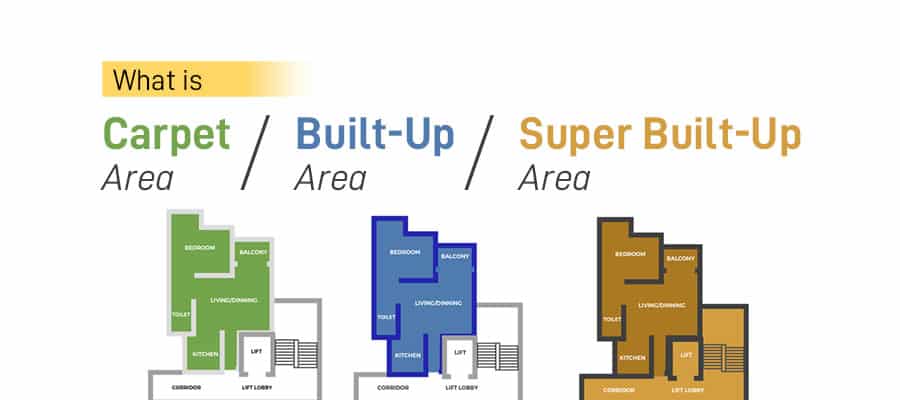In the world of real estate, there are several terms and concepts that can be confusing, especially for first-time homebuyers. Among these terms are “carpet area,” “built-up area,” and “super-built-up area.” Each of these measurements plays a crucial role in determining the space and cost of a property. In this article, we will delve into the specifics of these three areas to help you make an informed decision when buying or renting a property.
Table of Contents
- Introduction
- Carpet Area: The Core Living Space
- Built-Up Area: Adding Essential Spaces
- Super-Built-Up Area: The Bigger Picture
- Why Are These Measurements Important?
- Calculating Costs Based on Area
- Factors Affecting Area Measurements
- Legal Implications
- Choosing the Right Area for You
- Tips for Maximizing Space
- Future Trends in Real Estate Area Measurements
- Conclusion
- FAQs: Your Questions Answered
Introduction
When you start exploring properties in the real estate market, you’ll often come across terms like carpet area, built-up area, and super-built-up area. These terms are critical as they define the actual living space within a property, which directly impacts its functionality and cost.
Carpet Area?: The Core Living Space
The carpet area is the most fundamental measurement when it comes to a property’s space. It represents the actual area within the walls where you can place a carpet. In simpler terms, it is the usable area of your apartment or house. It includes all the rooms like bedrooms, living room, kitchen, and sometimes, attached balconies or verandas.

Built-Up Area?: Adding Essential Spaces
The built-up area expands upon the carpet area by including additional spaces. It comprises the carpet area plus the thickness of the walls, ducts, common areas, and other essential structural components. Essentially, it’s the space you would occupy if you consider the thickness of the walls as well.

Super-Built-Up Area?: The Bigger Picture
The super-built-up area is the most extensive measurement and often causes the most confusion. It encompasses the built-up area along with common facilities such as staircases, corridors, elevators, and amenities like a clubhouse, swimming pool, and garden. It represents the entire area that you indirectly share with other residents in the complex.

Why Are These Measurements Important?
Understanding these measurements is crucial because they directly impact your property’s price. Generally, the cost of a property is calculated based on the super-built-up area, which includes all shared spaces and amenities. However, when comparing properties, it’s essential to focus on the carpet area and built-up area to gauge the actual living space you’ll have.
Calculating Costs Based on Area
Real estate developers and builders price properties based on the super-built-up area. This means that when you buy a property, you’re paying for not only your living space but also your share of common facilities. It’s essential to evaluate whether the amenities justify the additional cost.
Factors Affecting Area Measurements
Several factors can affect these area measurements, including architectural designs, construction quality, and the builder’s intentions. Therefore, it’s advisable to carefully review the floor plans and consult with the builder or seller to understand precisely what each area measurement includes.
Legal Implications
In many regions, there are regulations in place that govern how carpet, built-up, and super-built-up areas are calculated. It’s vital to ensure that the property you’re interested in complies with these regulations to avoid any legal issues in the future.
Choosing the Right Area for You
The choice between carpet, built-up, and super-built-up area ultimately depends on your preferences and priorities. If you prioritize more living space, you may lean towards the carpet area. However, if you value amenities and shared facilities, the super-built-up area might be more appealing.
Tips for Maximizing Space
Regardless of which area measurement you choose, there are ways to optimize your space. Smart interior design, storage solutions, and decluttering can help you make the most of your property’s available space.
Future Trends in Real Estate Area Measurements
As real estate evolves, so do the methods of measuring space. With the rise of sustainable and smart housing, future area measurements might also incorporate eco-friendly spaces and advanced technologies.
Conclusion
In the complex world of real estate, understanding carpet area, built-up area, and super-built-up area is essential for making an informed decision. These measurements directly influence the cost and functionality of your property. By considering your needs and preferences, you can choose the right area measurement for your dream home.
FAQs: Your Questions Answered
- What is the primary difference between carpet area and built-up area?
- The carpet area represents the usable living space, while the built-up area includes additional spaces like walls and ducts.
- How do builders calculate the cost of a property?
- Builders typically price properties based on the super-built-up area, which includes shared facilities and amenities.
- Can the super-built-up area vary from one property to another in the same complex?
- Yes, the super-built-up area can vary based on the specific amenities and shared spaces offered by each property.
- Are there legal regulations governing these area measurements?
- Yes, many regions have regulations in place that dictate how carpet, built-up, and super-built-up areas are calculated.
- What should I prioritize when choosing an area measurement for my property?
- Your choice should align with your priorities. If you prefer more living space, focus on the carpet area. If amenities matter more, consider the super-built-up area.
In conclusion, understanding the distinctions between carpet area, built-up area, and super-built-up area empowers you to make a well-informed decision when buying or renting a property. These measurements serve as critical factors that affect both your living experience and your investment. Choose wisely, and your home will be a comfortable and enjoyable space for years to come.






